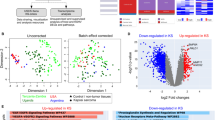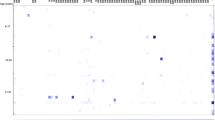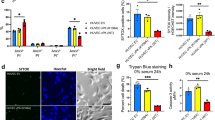Abstract
The biology of Kaposi sarcoma is poorly understood because the dominant cell type in Kaposi sarcoma lesions is not known1,2,3,4. We show by gene expression microarrays that neoplastic cells of Kaposi sarcoma are closely related to lymphatic endothelial cells (LECs) and that Kaposi sarcoma herpesvirus (KSHV)5,6 infects both LECs and blood vascular endothelial cells (BECs) in vitro. The gene expression microarray profiles of infected LECs and BECs show that KSHV induces transcriptional reprogramming of both cell types. The lymphangiogenic molecules VEGF-D and angiopoietin-2 were elevated in the plasma of individuals with acquired immune deficiency syndrome and Kaposi sarcoma. These data show that the gene expression profile of Kaposi sarcoma resembles that of LECs, that KSHV induces a transcriptional drift in both LECs and BECs and that lymphangiogenic molecules are involved in the pathogenesis of Kaposi sarcoma.
This is a preview of subscription content, access via your institution
Access options
Subscribe to this journal
Receive 12 print issues and online access
$259.00 per year
only $21.58 per issue
Buy this article
- Purchase on SpringerLink
- Instant access to full article PDF
Prices may be subject to local taxes which are calculated during checkout





Similar content being viewed by others
Accession codes
References
Regezi, J.A. et al. Human immunodeficiency virus-associated oral Kaposi's sarcoma. A heterogeneous cell population dominated by spindle-shaped endothelial cells. Am. J. Pathol. 143, 240–249 (1993).
Kaaya, E.E. et al. Heterogeneity of spindle cells in Kaposi's sarcoma: comparison of cells in lesions and in culture. J. Acquir. Immune Defic. Syndr. Hum. Retrovirol. 10, 295–305 (1995).
Gallo, R.C. The enigmas of Kaposi's sarcoma. Science 282, 1837–1839 (1998).
Kahn, H.J., Bailey, D. & Marks, A. Monoclonal antibody D2-40, a new marker of lymphatic endothelium, reacts with Kaposi's sarcoma and a subset of angiosarcomas. Mod. Pathol. 15, 434–440 (2002).
Chang, Y. et al. Identification of herpesvirus-like DNA sequences in AIDS-associated Kaposi's sarcoma. Science 266, 1865–1869 (1994).
Boshoff, C. & Weiss, R. AIDS-related malignancies. Nat. Rev. Cancer 2, 373–382 (2002).
Ganem, D. KSHV and Kaposi's sarcoma: the end of the beginning? Cell 91, 157–160 (1997).
Dupin, N. et al. Distribution of human herpesvirus-8 latently infected cells in Kaposi's sarcoma, multicentric Castleman's disease, and primary effusion lymphoma. Proc. Natl. Acad. Sci. USA 96, 4546–4551 (1999).
Stacker, S.A., Achen, M.G., Jussila, L., Baldwin, M.E. & Alitalo, K. Lymphangiogenesis and cancer metastasis. Nat. Rev. Cancer 2, 573–583 (2002).
Flore, O. et al. Transformation of primary human endothelial cells by Kaposi's sarcoma- associated herpesvirus. Nature 394, 588–592 (1998).
Moses, A.V. et al. Long-term infection and transformation of dermal microvascular endothelial. J. Virol. 73, 6892–6902 (1999).
Ciufo, D.M. et al. Spindle cell conversion by Kaposi's sarcoma-associated herpesvirus: formation of colonies and plaques with mixed lytic and latent gene expression in infected primary dermal microvascular endothelial cell cultures. J. Virol. 75, 5614–5626 (2001).
Li, C. & Wong, W.H. Model-based analysis of oligonucleotide arrays: expression index computation and outlier detection. Proc. Natl. Acad. Sci. USA 98, 31–36 (2001).
Lebbe, C. et al. Characterization of in vitro culture of HIV-negative Kaposi's sarcoma-derived cells. In vitro responses to alfa interferon. Arch. Dermatol. Res. 289, 421–428 (1997).
Samaniego, F., Markham, P.D., Gendelman, R., Gallo, R.C. & Ensoli, B. Inflammatory cytokines induce endothelial cells to produce and release basic fibroblast growth factor and to promote Kaposi's sarcoma-like lesions in nude mice. J. Immunol. 158, 1887–1894 (1997).
Brockmeyer, N.H. et al. Cytokine profile of HIV-positive Kaposi's sarcoma derived cells in vitro. Eur. J. Med. Res. 4, 95–100 (1999).
Makinen, T. et al. Isolated lymphatic endothelial cells transduce growth, survival and migratory signals via the VEGF-C/D receptor VEGFR-3. EMBO J. 20, 4762–4273 (2001).
Vieira, J., O'Hearn, P., Kimball, L., Chandran, B. & Corey, L. Activation of Kaposi's sarcoma-associated herpesvirus (human herpesvirus 8) lytic replication by human cytomegalovirus. J. Virol. 75, 1378–1386 (2001).
Petrova, T.V. et al. Lymphatic endothelial reprogramming of vascular endothelial cells by the Prox-1 homeobox transcription factor. EMBO J. 21, 4593–4599 (2002).
Gale, N.W. et al. Angiopoietin-2 is required for postnatal angiogenesis and lymphatic patterning, and only the latter role is rescued by Angiopoietin-1. Dev. Cell 3, 411–423 (2002).
Poole, L.J. et al. Altered patterns of cellular gene expression in dermal microvascular endothelial cells infected with Kaposi's sarcoma-associated herpesvirus. J. Virol. 76, 3395–3420 (2002).
Ferrara, N., Gerber, H.P. & LeCouter, J. The biology of VEGF and its receptors. Nat. Med. 9, 669–676 (2003).
Ascherl, G. et al. Infection with human immunodeficiency virus-1 increases expression of vascular endothelial cell growth factor in T cells: implications for acquired immunodeficiency syndrome-associated vasculopathy. Blood 93, 4232–4241 (1999).
Renwick, N. et al. Vascular endothelial growth factor levels in serum do not increase following HIV type 1 and HHV8 seroconversion and lack correlation with AIDS-related Kaposi's sarcoma. AIDS Res. Hum. Retroviruses 18, 695–698 (2002).
Shin, D. et al. Expression of ephrinB2 identifies a stable genetic difference between arterial and venous vascular smooth muscle as well as endothelial cells, and marks subsets of microvessels at sites of adult neovascularization. Dev. Biol. 230, 139–150 (2001).
Hong, Y.-K. et al. Lymphatic reprogramming of blood vascular endothelium by Kaposi sarcoma–associated herpesvirus. Nat. Genet. advance online publication, 27 June 2004 (doi:10.1038/ng1383).
Orenstein, J.M. et al. Visualization of human herpesvirus type 8 in Kaposi's sarcoma by light and transmission electron microscopy. AIDS 11, F35–F45 (1997).
Irizarry, R.A. et al. Summaries of Affymetrix GeneChip probe level data. Nucleic Acids Res. 31, E15 (2003).
Storey, J.D. & Tibshirani, R. Statistical significance for genomewide studies. Proc. Natl. Acad. Sci. USA 100, 9440–9445 (2003).
Kruskal, J.B. Multidimensional scaling by optimizing goodness of fit to a nonmetric hypothesis. Psychometrika 29, 1–27 (1964).
Acknowledgements
We thank the AIDS-Malignancy Bank of the US National Cancer Institute for providing the Kaposi sarcoma biopsy samples used in this study; M. Byers, S. Crane, D. MacDonald, D.B. Guiliano, A. Godfrey and R. Dunbar for technical expertise; J. Vieira for providing the BCBL-1 cell line producing KSHV-GFP; and R. Ambinder for providing the JSC-1 cell line. We apologize to the many scientists whose work we did not cite due to space constraints. This work is supported by Wellcome Trust, European Union, Cancer Research UK and the Medical Research Council.
Author information
Authors and Affiliations
Corresponding author
Ethics declarations
Competing interests
The authors declare no competing financial interests.
Supplementary information
Supplementary Fig. 1
Hierarchical cluster of 35 samples and a filtered set of 5894 genes. (PDF 1860 kb)
Supplementary Fig. 2
Infection of KSHV in LECs and BECs. (PDF 158 kb)
Supplementary Table 1
Gene differentially expressed between KS and normal skin, or between LECs and BECs. (XLS 665 kb)
Supplementary Table 2
Average linkage distances between each sample group. (PDF 6 kb)
Rights and permissions
About this article
Cite this article
Wang, HW., Trotter, M., Lagos, D. et al. Kaposi sarcoma herpesvirus–induced cellular reprogramming contributes to the lymphatic endothelial gene expression in Kaposi sarcoma. Nat Genet 36, 687–693 (2004). https://doi.org/10.1038/ng1384
Received:
Accepted:
Published:
Issue date:
DOI: https://doi.org/10.1038/ng1384
This article is cited by
-
High levels of LINE-1 transposable elements expressed in Kaposi’s sarcoma-associated herpesvirus-related primary effusion lymphoma
Oncogene (2021)
-
To be or not to be: endothelial cell plasticity in development, repair, and disease
Angiogenesis (2021)
-
Kaposi sarcoma
Nature Reviews Disease Primers (2019)
-
PROX1 is a transcriptional regulator of MMP14
Scientific Reports (2018)
-
CK1α suppresses lung tumour growth by stabilizing PTEN and inducing autophagy
Nature Cell Biology (2018)



